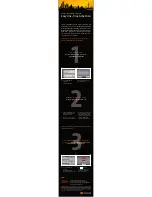
SECTION TWO - Installation
Page 22
961 INSTALLATION MANUAL Revision A
Installing an 8410
ACU (for use with
the AN150 only)
If you want to receive differential corrections with the 961 and you’re
using the AN150 antenna, you must use the Northstar 8410 Antenna
Coupling Unit (ACU). Although similar in appearance to Northstar loran
ACUs, only the unit labeled “8410” will work with the internal DGPS
receiver. The ACU also serves as a sturdy mounting base for the whip
antenna.
Mounting the 8410
The Northstar 8410 differential receiver antenna should be mounted as
high as conveniently possible (but not at the highest point) and as far
away as possible from other antennas. If you have several possible
antenna locations, you may evaluate each by operating the unit with the
DGPS antenna temporarily mounted in each location.
The best location is one providing the lowest
“noise”
count (atmospheric
impulse noise generated by thunderstorms and other conditions, includ-
ing vessel-generated noise and any on-board interference) and highest
Signal-to-Noise Ratio (SNR). You can view both of these values after you
turn the unit’s power on; see “Turning the unit on” beginning on page 26.
Another major concern, precipitation static (called “P-static”), must be
addressed when installing the differential antenna. The 8410 receives
weak AM signals and can be sensitive to nearby noise sources and
P-static. P-static generally appears only during rain or snow; conse-
quently, it can easily be overlooked during installation. Much like a loran
antenna, the effects of P-static are minimized if the differential antenna is
mounted so that it isn’t the highest metallic object on the vessel. The
highest metal object acts much like a lightning rod, attracting tiny static
discharges in the atmosphere. If the differential receiver antenna is the
highest object, these discharges can totally override the differential sig-
nals and cause poor operation in bad weather. The optimum antenna
location is high and clear for fair-weather operation, but below the top of
a metal mast or other antenna for best foul-weather operation. On sailing
vessels, the ACU might be mounted on top of a low mast, or on the stern
rail if no other suitable location is available.
The 8410 differential receiver ACU can be mounted on a standard marine
antenna mount (one inch diameter, 14 threads per inch).
For special applications involving serious grounding problems, or where
optimum portability is required, you can use the AN205-P combination
GPS/DGPS antenna; for details, see “Installing the AN205-P antenna”
beginning on page 19.
The ACU consists of two pieces, the body and the base. The circuitry is
sealed in a rugged, waterproof, fiberglass polycarbonate body, the upper
end of which is threaded to accept a standard 4-foot whip antenna. A
large female thread is molded into the lower portion, or base, of the ACU
Содержание 961X
Страница 2: ......
Страница 4: ......
Страница 6: ...Page ii 961 INSTALLATION MANUAL Revision A ...
Страница 10: ...Page vi 961 INSTALLATION MANUAL Revision A ...
Страница 54: ...SECTION TWO Installation Page 44 961 INSTALLATION MANUAL Revision A ...














































